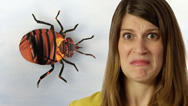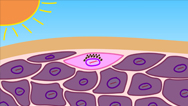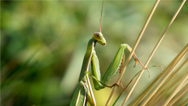Four Deadly Carnivorous Plants
- By Anna Rothschild
- Posted 08.18.16
- NOVA
Discover four ingenious ways carnivorous plants catch their prey in this episode of Gross Science.
Transcript
Four Deadly Carnivorous Plants
Posted: August 18, 2016
Anna: They snap, they trap, they stick, and they suck. This is the bizarre world of carnivorous plants—leafy creatures that eat everything from insects, to crustaceans, to mammals.
I’m Anna, and this is Gross Science.
The vast majority of plants only require a few things to survive: sunlight, water, air, and mineral nutrients, which they typically get from the soil or pond water they’re growing in. These nutrients are elements like nitrogen and phosphorus, which are building blocks for things like DNA and proteins. But most carnivorous plants live in places without a lot of nutrients, like peat bogs. So to really thrive, they draw extra nutrition from the bodies of unsuspecting prey.
Now, carnivory has actually evolved multiple times in plants all over the world, giving rise to some wildly diverse and morbidly beautiful methods for catching food. So, Vanessa from BrainCraft and I bought a few carnivorous plants!
Vanessa: They’re so beautiful.
Anna: They really are.
Vanessa: Yeah.
Anna: And I’m going to show you some of my favorites. You ready, Vanessa?
Vanessa: I’m scared and kind of excited all at once.
Anna: Me too! Ok, so first, this is the bladderwort. These guys live in watery environments, but they have these small, empty chambers growing from their stems. When a tiny creature—like a crustacean—passes by, it brushes against these things called trigger hairs. The hairs make the door to the chamber pop open, and as water rushes in to fill the empty space inside, the tiny crustacean gets sucked in, too. This entire process happens in less than a thousandth of a second—the video you’re watching here has been slowed way down. Then the bladderwort releases digestive enzymes into the chamber to break down the insect’s body and lap up its nutrients. After its meal, the chamber squeezes out all the water, closes the door, and is ready to catch more prey.
Vanessa: Wow.
Anna: But that’s only one variety of carnivorous plant. Other types of carnivorous plants act totally differently. For example, the leaves of sundews are covered in delicate, wispy hairs, each with a teeny drop of liquid at the end. Thinking the liquid is actually delicious nectar, insects fly in to grab a tasty drink. But those dewdrops are actually sticky and trap the bug. The wispy tentacles curl around the insect, holding it tightly and maximizing the number of hairs it touches, which speeds up digestion.
Vanessa: What I find so cool is the way sundews operate is like a botanical version of brains and muscles . So, while they don’t have brain cells they do have chemical signals to move which kind of acts as a brain.
Anna: That’s so amazing, it’s a really good analogy. The other really cool thing is that there are actually some carnivorous plants that actually capture prey without moving at all. So, pitcher plants have deep basins filled with digestive enzymes. Insects venture in looking for food, but then they can’t get back out. There are tons of different varieties of these plants, but in this species, called Sarracenia flava, the inside of the pitcher is slippery, so bugs fall in and then can’t crawl up the walls. They also have downward pointing hairs at the bottom of the pitcher that make climbing out even more difficult for the insects. And some species of pitcher plant can catch more than just bugs. Certain tropical pitcher plants are so large that they’ve been known to trap small rodents, like mice and rats.
Vanessa: That’s scary. That’s very scary.
Anna: It absolutely is. But, next is a type of plant that might be a little bit more familiar.
Vanessa: It is more familiar.
Anna: This is the Venus flytrap. These plants have book-like leaves, which emit a sweet smell that attracts insects, like flies. When a fly lands on the leaf, it brushes against trigger hairs. Touching the hair sends a little electric charge through the leaf. And each charge stimulates pores to open, which allow water to move from one part of the leaf to another. The changes in water pressure make the book snap shut in under a second.
However, the plant will only close if at least two hairs are touched in under about 20 seconds—or if the same hair is triggered twice in the same amount of time. Then, the struggling prey needs to touch more hairs before the flow of digestive juices begins. This keeps the plant from wasting precious resources on a false alarm—like a floating speck of dirt or a curious human setting off the snare for fun.
Vanessa: So, when you’re talking about these electrical charges, you’re really referring to something called action potentials. And these are signals our own brains’ neurons use to pass on information to each other. So, we don’t tend to think about it, but it’s kind of amazing how similar we are to plants.
Anna: Yeah, we don’t tend to think about it and that is really amazing. And Vanessa actually has a whole video about this over on her channel, and I’ll put a link to it somewhere on this screen. Definitely go check it out. It’s so cool.
Vanessa: Thank you.
Anna: Anyway, these were just a few examples of the diversity of these deadly traps. But the variety out there is really quite extraordinary—in fact, there are over 750 individual species of carnivorous plants worldwide. And by the way, many of them are easy to find and to care for. So if you have some of these plants at home, let me know. I’d love to see your gruesomely beautiful garden grow.
Vanessa: This one’s really sticky.
Anna: Ewww!
Credits
PRODUCTION CREDITS
- Host, Writer, Animator, Editor
- Anna Rothschild
- Original Footage
- ©WGBH Educational Foundation 2016
- Keep an Eye on this One/Another
- Walk in the Park
- Music Provided by APM
- Bladderwort Footage
- Courtesy Philippe Marmottant
- Venus flytrap catching a fly
- Sinclair Stammers/Science Photo Library
- Cape sundew engulfing an insect
- Francis Chee/Science Photo Library
- Bladderwort Traps Prey Light Microscope
- Thierry Berrod/Science Photo Library
- Spider Trapped in Pitcher Plant
- James H. Robinson/Science Photo Library
- Sundew Fly Trap Plant
- Pond5/GSMotion
- Dead Insect Inside Pitcher Plant
- Shutterstock/Roger de Montfort
- Sarracenia Judith Hindle (4753019871)
- Wikimedia Commons/David Eickhoff
- Sunset in the Peat Bog (15684909747)
- Wikimedia Commons/incidencematrix
- AldrovandaVesiculosaHabit
- Wikimedia Commons/Jan Wieneke
- ByblisLinifloraHabitus
- Wikimedia Commons/Denis Barthel
- Darlingtonia californica ne8
- Wikimedia Commons/NoahElhardt
- Uk pond bladderwort2
- Wikimedia Commons/Veledan
- N. andamana
- Wikimedia Commons/Marcello Catalano
- Ile de Mahe - Plantes carnivores (3)
- Wikimedia Commons/Remi Jouan
- Common Bladderwort (3629436369)
- Wikimedia Commons/Jason Hollinger
- Common Bladderwort
- Wikimedia Commons/pellaea
- Drosera rotundifolia leaf1
- Wikimedia Commons/Petr Dlouhý
- Drosera Capensis eating a fruit fly
- Wikimedia Commons/Scott Schiller
- Pitcher Plants
- Flickr/Dave Bonta
- Sarracenia leucophylla
- Flickr/Aaron Carlson
- Sarracenia ‘Boob Tube’ x open-pollinated
- Flickr/Aaron Carlson
- Sarracenia oreophila x purpurea
- Flickr/Aaron Carlson
- Pitcher Plants..lots of them!
- Flickr/vladeb
- IMG_1757
- Graeme Scott
- Terrestrial shrew remains examined in Nepenthes attenboroughii by Dr Alastair S Robinson
- Wikimedia Commons/Alastair S. Robinson
- Venus Fly Trap Eating Compilation Scott's Revenge On The Caterpillars
- Wikimedia Commons/Scott Schiller
- Dionea in action
- Wikimedia Commons/Stefano Zucchinali
SFX
- Cockroaches
-
Freesound/StateAardvark
(used with permission from author) - Squeak Pack/squeak_10
- Freesound/Corsica_S
- Shuffling Cards
- Freesound/robertwulfman
- Wink
- Freesound/bennychico11
- Nord analog howling wind storm
- Freesound/medialint
- Sniff
- Freesound/jrssandoval
- Flying Mosquito
- Freesound/zywx
- Produced by WGBH for PBS Digital Studios
POSTER IMAGE
- Drosera rotundifolia leaf1
- Wikimedia Commons/Petr Dlouhý
Sources
Want more info?
Proceedings of the Royal Society B: Biological Sciences
(2011) Ultra-fast underwater suction traps.
http://bit.ly/2a3fVLN
Current Biology (2016) The Venus Flytrap Dionaea muscipula
Counts Prey-Induced Action Potentials to Induce Sodium
Uptake
http://bit.ly/2a3gy8h
Scienceline: How Does a Venus Flytrap Work?
http://bit.ly/2a3guVU
International Carnivorous Plant Society
http://bit.ly/2a3gV2H
Related Links
-

Gross Science
Bizarre stories from the slimy, smelly, creepy world of science.
-

What Really Causes Sunburns?
The way the sun damage your skin is weirder than you ever thought.
-

Sea Turtles Get Herpes, Too
Sea turtles can get herpes. And human pollution might be making their flare-ups worse.
-

Science and Sex Bias
Science has historically ignored females, whether they're insects, lab rats, or humans.

